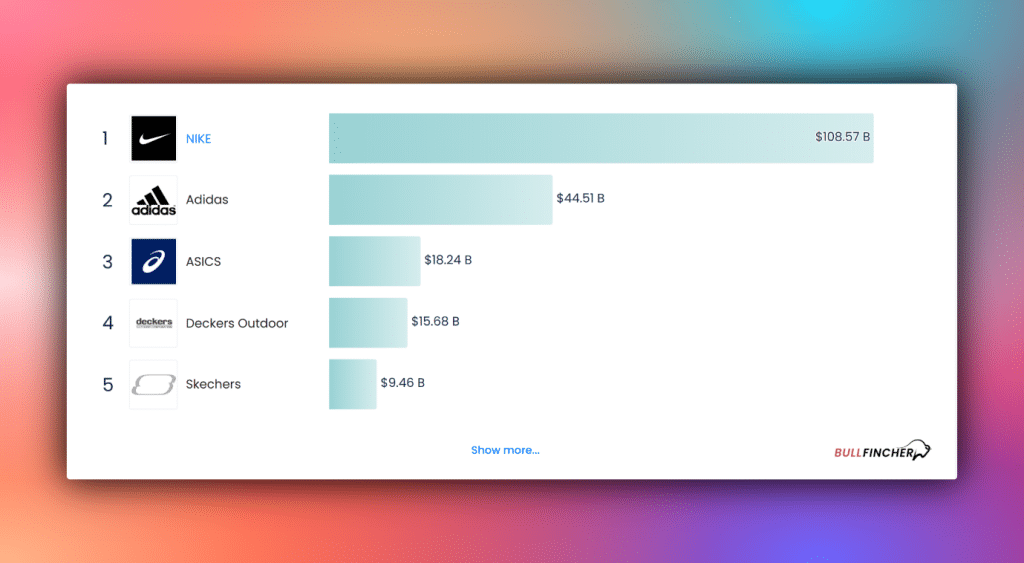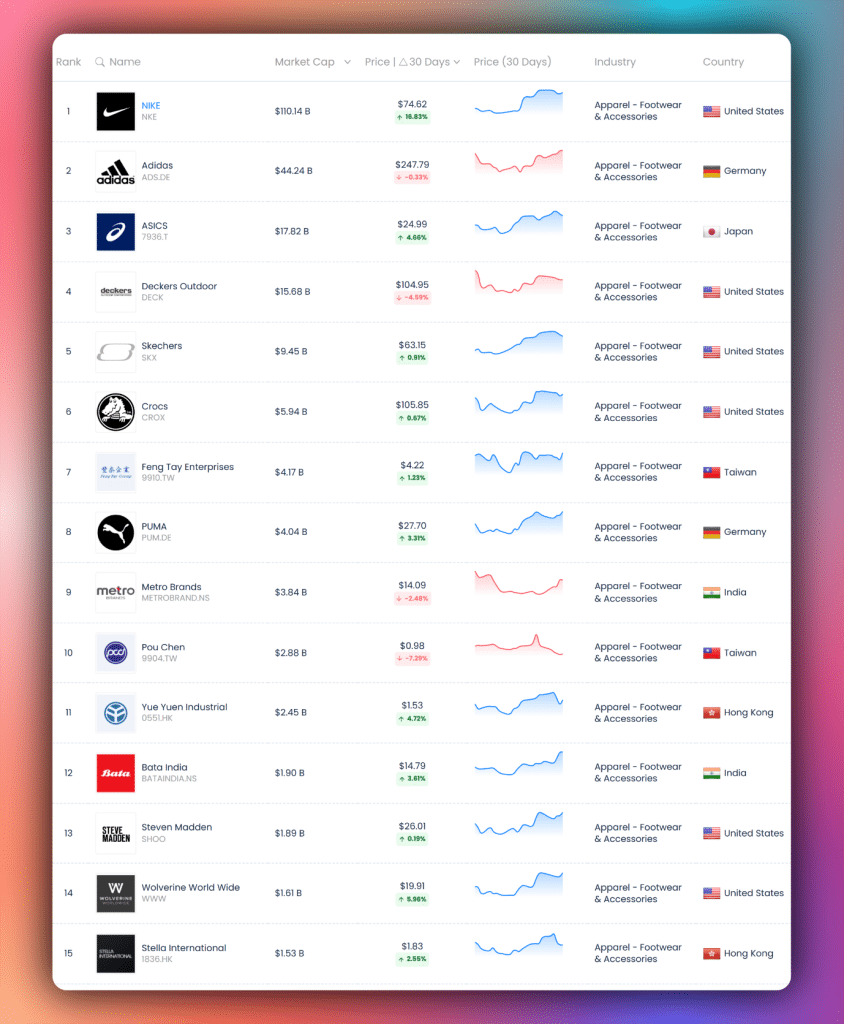- Company: Adidas AG
- CEO: Bjørn Gulden
- Year founded: 1924
- Headquarters: Herzogenaurach, Bavaria, Germany
- Number of Employees: 62,035
- Type: Public
- Ticker Symbol: ADS
- Market Cap (Mar 2025): €39.17 Billion
- Annual Revenue (FY 2024): €23.7 Billion
- Profit | Net income (FY 2024): €824 Million
Products & Services: Sportswear | Lifestyle & Fitness Apparel | Sports & Casual Footwear | Accessories | Fitness Equipment | Balls | Golf Clubs
Competitors: Nike | Reebok | Under Armour | ASICS | PUMA | New Balance | Converse | Fila | Allbirds | Liberty Shoes | Bata | Lululemon | K-Swiss | Callaway Golf Company | Columbia Sportswear | Arc’teryx
Did you know? Adidas bought its iconic three-stripe logo in 1952 from Finnish company Karhu Sports for €1,600 and two bottles of whiskey.
Adidas is a German athletic apparel and footwear company founded by Adolf and Rudolf Dassler as the Dassler Brothers Shoe Factory in their mother’s house. Rudolf established Puma in 1949 after a breakdown in the relationship with his brother Adolf. The Adidas Group also owns a stake in the Bayern Munich football club and the Runtastic fitness tech brand. In 2024, Adidas Group generated €23.7 billion in annual revenue. Its profit was €824 million, up from a €58 million net loss in 2023. [1]
Adidas is Europe’s largest sportswear manufacturer and the world’s second-largest after Nike. It has one of the most instantly recognizable logos globally. Adidas’ mission, purpose, values, and sustainability strategy drive growth and success. As of 2024, Adidas had a brand value of around $14.5 billion. It is among the top ten largest apparel brands worldwide. [2]
Checkout: Largest Global Footwear Companies by Market Cap
To understand Adidas’ secret to success for 100 years, here is an in-depth analysis of its mission statement, purpose, values, and sustainability targets:
Adidas’ Mission Statement
To be the best sports brand in the world.
Adidas states, “Athletes do not settle for average, and neither do we. Every day, we work to create and sell the best sports products in the world, offer the best service and consumer experience – and do it all sustainably. We are the best when we are a credible, inclusive, and sustainable leader in our industry.” [3]
Here is our analysis of Adidas’ mission statement:
1. Deliver the best sports products worldwide
Adidas strives to create the world’s best sports products. The company has worked to achieve this mission since its founding. Its founder, Adolf Dassler, persuaded US sprinter Jesse Owens for his handmade spikes at the 1936 Summer Olympics. The brand recently disrupted performance across sports with three groundbreaking designs: the Adizero Adios Pro Evo 1, Agravic Speed Ultra, and F50+.
Adidas’ Adizero Adios Pro Evo 1 is an innovative road racer with 22 race wins, including two world records and an Olympic record. It weighs 138 grams (4.87 ounces), 40% lighter than previous models. Tigist Assefa broke the women’s marathon world record by over a minute, and Tigist Ketema won the 2024 Berlin marathon by more than two minutes. Both runners wore Adidas’ Adizero Adios Pro Evo 1. The Agravic Speed Ultra is the go-to trail running shoe, while the F50+ is perfect for footballers. In 2025, Adidas ranked 7th on Fast Company’s 10 Most Innovative Companies list in the sports category. [4]
2. Offer the best service and consumer experience
Adidas seeks to provide world-class customer service and consumer experience. It achieves this mission by personalizing its offerings and marketing content. First, Adidas segments its customer base based on gender, location, and past purchases. Then, the brand crafts targeted email campaigns to address each group’s needs and desires. Its personalized emails have higher engagement rates than generic campaigns. Adidas also offers a running app to deliver customized content. [5]
Adidas combines tech-driven solutions and strategies to offer industry-leading service and customer experience. Its digital transformation began in 2018 at the DevOps Enterprise Summit in London. The brand reimagined its tech approach to transform into a digital-first company and reach a 50% direct-to-consumer business by 2025. For example, Adidas aligned its teams with steps in the consumer journey instead of organizing them around traditional IT silos. This customer-centric approach ensured that technology development was tied to customer needs. It enhances product discovery, checkout experience, and post-purchase engagement. [6]
3. Produce sports goods sustainably
Adidas is committed to manufacturing sports products sustainably. It is a founding member of game-changing initiatives like Better Cotton, the Leather Working Group, and the Fair Labor Association. In 2021, Adidas doubled down on its commitment to sustainability. Its strategy focuses on material innovation, switching to cleaner energy sources at supplier facilities, and enabling low-carbon product designs. The company recently committed to Canopy’s CanopyStyle and Pack4Good initiatives to eliminate fiber sourced from climate-critical forests in textiles, paper, and paper packaging from its sports products and adopt low-carbon and circular alternatives. [7]
Image Credit: JC Gellidon
Adidas’ Purpose
Through sport, we have the power to change lives. [8]
Everything Adidas does is rooted in sports. The company believes sports play a crucial role in many people’s lives, on and off the playground. Adidas’ purpose guides its operations, partnerships, production, and consumer engagement. It uses sports to unite and empower people and nurture a more sustainable world. For example, Adidas partnered with football star Mohamed Salah in Mar 2025 to highlight the benefit of positivity from coaches, parents, fans, and teammates in helping to make athletes believe “You Got This.” Salah visited a young girl’s football team in Liverpool to demonstrate the positive behavior athletes need from the sidelines. [9]
Adidas’ Values
Adidas’ culture is founded on six values: courage, ownership, innovation, teamplay, integrity, and respect. These principles are the essence of the company’s identity. They unite Adidas’ 62,035 employees from 160 nationalities and ensure each member brings their uniqueness to work daily. They also define the behaviors and mindsets that Adidas values in colleagues. [10]
How does Adidas live by its values?
1. Courage
Adidas follows the footsteps of its courageous pioneer, Adi Dassler. “Those who are against new developments or testing new things should not hinder those who are willing,” Adi Dassler once said. This philosophy has guided Adidas for 100 years, from starting as a small business to collaborating with Bored Ape Yacht Club founders and launching non-fungible tokens (NFTs) on adidas.com. The brand was courageous when it ventured into the metaverse and ordered 30,000 bespoke tracksuits for people whose address it didn’t have. These bold moves gave the company a first-mover advantage in design patents, emerging tech, and digital applications. [11]
2. Ownership
Adidas values people who own everything they do. “Ownership is about doing the right thing for our company,” says the leader of Adidas’ tech, Andreas Hubert. It allows people with different skills and attitudes to find the best way to work and harness their unique strengths. Sharing and assigning ownership give employees a sense of purpose and help team leaders steer projects to completion. Adidas encourages its top management to build a culture of ownership by listening to its juniors. [12]
3. Innovation
Adidas values out-of-the-box thinking and creative ideas. It creates a conducive environment for all employees to maximize creativity, hastening innovation. In 2025, Adidas was one of Fast Company’s top 10 most innovative companies in sports. It was recognized for three groundbreaking designs: the record-shattering Adizero Adios Pro Evo 1, the trail-running Agravic Speed Ultra, and the F50+ (football’s first-ever “supershoe”). The Adidas Innovation Lab collaborates with athletes to redefine performance across sports. [13]
4. Teamplay
Adidas nurtures collaboration and teamwork organization-wide. For example, Adidas makes over 25,000 articles across apparel, footwear, and accessories every season. Several teams create these products in different locations globally, from Portland and LA in the US to Shanghai in China and Herzogenaurach in Germany. Teamplay is crucial for all business units and functions along the entire value chain to achieve the same goal. It collaborates with designers, suppliers, distributors, marketers, and salespeople to deliver the best sports goods to consumers sustainably and cost-effectively. [14]
5. Integrity
Adidas strives to build an ethical business that empowers people and protects the planet. It has committed to improving diversity and addressed accusations concerning unfair labor practices. In 2022, Adidas scored 128 (51%) in the Fashion Transparency Index (FTI), down from 136 (54%) in 2021. The FTI is an ethical performance rating of worldwide brands focused on workers’ welfare and labor practices. Adidas is in the same bracket as its competitors: Nike, Lululemon, and Converse. As a Fair Labor Association (FLA) member, Adidas strives to improve labor conditions in its supply chain. Its Code of Conduct is reflective of the FLA’s. [15]
6. Respect
Adidas strives to create an inclusive workplace where all employees are respected and valued. The brand is reimaging its diversity, equity, and inclusion (DEI) journey to focus on its people, culture, and managerial accountability. “People need transparency, honesty, and leaders to do what they said they would,” said Adidas DEI head Vanessa Abrahams-John, “If we put respect at the heart of what we do and deliver on our DEI promises, we will win because we played fair.” The company encourages its managers to set the best example of respect in the workplace. [16]
Checkout: Largest footwear companies in world by market cap
Adidas Sustainability Targets
Adidas is committed to building a sustainable company that protects the environment and changes lives. Its sustainability strategy focuses on employees, nature, circularity, materials, and the supply. The sportswear giant has set ambitious sustainability targets, including:
- Reach net zero by 2050.
- Reduce Scope 1 and 2 emissions by around 70% and Scope 3 by 43% by 2030.
- Ensure that 10% of the polyester used in its products comes from recycled textile waste by 2030.
- Divert 98% of waste from T1 and T2 suppliers from landfills by 2025.
- Reduce water consumption intensity in the supply by 40% and 15% for company-owned operations by 2025.
- Achieve deforestation- and conversion-free (DCF) bovine leather supply chain by 2030.
- Ensure 100% of the value chain and operations have a system for identifying and managing high-risk human rights issues by 2025.
- Improve all fair compensation benchmarks in strategic Tier 1 suppliers by 2025.
- Ensure 90% of Tier 1 strategic suppliers achieve a 4S rating by 2025. [17]
How is Adidas progressing on its sustainability targets?
Adidas combines several strategies to achieve its sustainability targets. It has launched cross-industry circularity projects, including T-REX (Textile Recycling Excellence) and Sorting for Circularity. T-REX helped Adidas achieve a 99% usage rate for recycled polyester. In 2024, Adidas reduced Scope 1 and 2 emissions by 17%, Scope 3 by 20%, and carbon intensity by 5.3%. It posted a 20% reduction across all three scopes. [18]
Adidas supports initiatives that promote environmental conservation and biodiversity. It has a comprehensive nature-focused strategy to achieve deforestation- and conversion-free supply chains for high-risk-commodities by 2030. In 2024, Adidas had reduced water consumption intensity in its supply chain by 34%. Its 2025 target is 40%. The brand decreased water consumption intensity in owned operations by 17% in 2024, surpassing its 15% goal ahead of schedule. The company collaborates with Textile Exchange, Leather Working Group, and the World Wide Fund for Nature (WWF) to create industry standards for deforestation-free materials and traceability mechanisms. [19]
References
- Davies, K. (2024, Mar 17). Adidas revenue 2000-2024. Statista
- Davies, K. (2025, Mar 27). Adidas: Statistics & facts. Statista
- Adidas Group. Profile: About us. Adidas-Group.com
- Mueller, P. (2025, Mar 18). The most innovative companies in sports for 2025. Fast Company
- Donlan, K. (2025, Feb 24). Personalized Customer Experience: What It Looks Like in 2025 and Beyond. Emarsys
- Brown, L. (2024, Oct 22). Sprinting into the Digital Age: Adidas’ Multi-Year Digital Transformation. IT Revolution
- Birch, K. (2024, Feb 28). How Adidas is Innovating to Make Sportswear More Sustainable. Sustainability Magazine
- Adidas Group. Profile: Our Purpose. Adidas-Group.com
- Adidas (2025, Mar 28). Mohamed Salah and Adidas lead the charge for positive sideline support, empowering young athletes to believe “You Got This.” Adidas.com
- Adidas Group. People and Culture: What we believe in. Adidas-Group.com
- Wykes-Sneyd, E. (2023, Feb 17). Real Courage in Business isn’t about Bold Leaps into the unknown. It’s a Shared Mindset to Help You Take the Shot. Adidas Group
- Hubert, A. (2023, Jan 23). Take ownership to empower your team. Adidas Group
- Adidas (2025, Mar 21). We’ve been recognized as one of the top 10 most innovative companies in sports for 2025 by Fast Company. Adidas.com
- Bührle, S. (2023, Feb 7). It Takes Teamwork, Collaboration, and Curiosity to Achieve Sustainability at Scale. Adidas Group
- Feria, M. (2023, Jun 21). Is Adidas Sustainable & Ethical? Sustainly
- Abrahams-John, V. (2023, Jan 31). Discover how the Adidas DEI strategy enables the core value of respect in the workplace. Adidas Group
- Adidas Group (2024, Jul 30). Sustainability: Our Targets. Adidas-Group.com
- Jessen, J. (2025, Mar 13). Adidas’ approach to growth and sustainability. Sustainability Magazine
- Adidas Group (2025, Jan 15). Our Gameplan: Nature. Adidas-Group.com
- Featured Image by Camilla Carvalho
- Shoes image by JC Gellidon





















Add comment